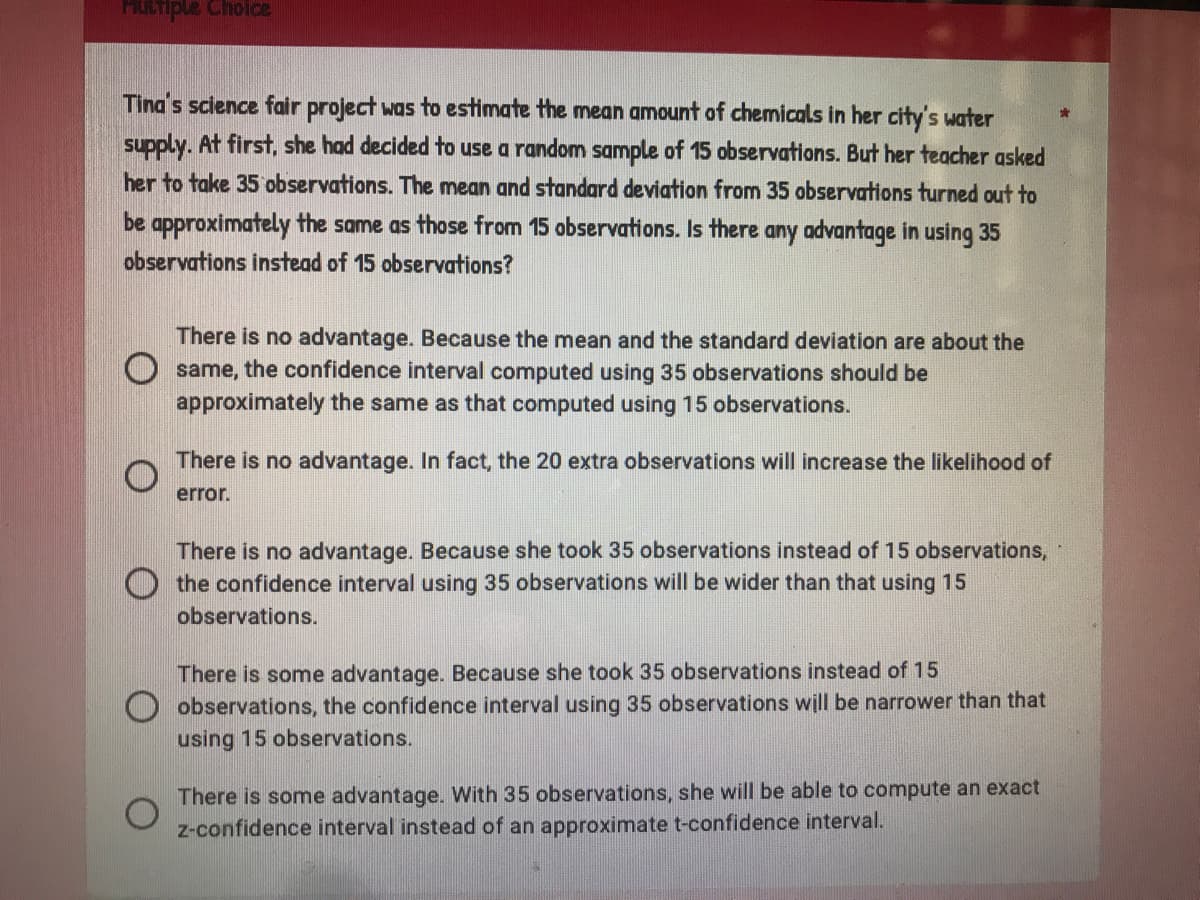Tina's science fair project was to estimate the mean amount of chemicals in her city's water supply. At first, she had decided to use a random sample of 15 observations. But her teacher asked her to take 35 observations. The mean and standard deviation from 35 observations turned out to be approximately the same as those from 15 observations. Is there any advantage in using 35 observations instead of 15 observations? There is no advantage. Because the mean and the standard deviation are about the Osame, the confidence interval computed using 35 observations should be approximately the same as that computed using 15 observations. There is no advantage. In fact, the 20 extra observations will increase the likelihood of
Tina's science fair project was to estimate the mean amount of chemicals in her city's water supply. At first, she had decided to use a random sample of 15 observations. But her teacher asked her to take 35 observations. The mean and standard deviation from 35 observations turned out to be approximately the same as those from 15 observations. Is there any advantage in using 35 observations instead of 15 observations? There is no advantage. Because the mean and the standard deviation are about the Osame, the confidence interval computed using 35 observations should be approximately the same as that computed using 15 observations. There is no advantage. In fact, the 20 extra observations will increase the likelihood of
Glencoe Algebra 1, Student Edition, 9780079039897, 0079039898, 2018
18th Edition
ISBN:9780079039897
Author:Carter
Publisher:Carter
Chapter10: Statistics
Section10.4: Distributions Of Data
Problem 22PFA
Related questions
Question

Transcribed Image Text:Multiple choice
Tina's science fair project was to estimate the mean amount of chemicals in her city's water
supply. At first, she had decided to use a random sample of 15 observations. But her teacher asked
her to take 35 observations. The mean and standard deviation from 35 observations turned out to
be approximately the same as those from 15 observations. Is there any advantage in using 35
observations instead of 15 observations?
There is no advantage. Because the mean and the standard deviation are about the
same, the confidence interval computed using 35 observations should be
approximately the same as that computed using 15 observations.
There is no advantage. In fact, the 20 extra observations will increase the likelihood of
error.
There is no advantage. Because she took 35 observations instead of 15 observations,
the confidence interval using 35 observations will be wider than that using 15
observations.
There is some advantage. Because she took 35 observations instead of 15
observations, the confidence interval using 35 observations will be narrower than that
using 15 observations.
There is some advantage. With 35 observations, she will be able to compute an exact
z-confidence interval instead of an approximate t-confidence interval.
Expert Solution
This question has been solved!
Explore an expertly crafted, step-by-step solution for a thorough understanding of key concepts.
Step by step
Solved in 2 steps

Recommended textbooks for you

Glencoe Algebra 1, Student Edition, 9780079039897…
Algebra
ISBN:
9780079039897
Author:
Carter
Publisher:
McGraw Hill

Glencoe Algebra 1, Student Edition, 9780079039897…
Algebra
ISBN:
9780079039897
Author:
Carter
Publisher:
McGraw Hill